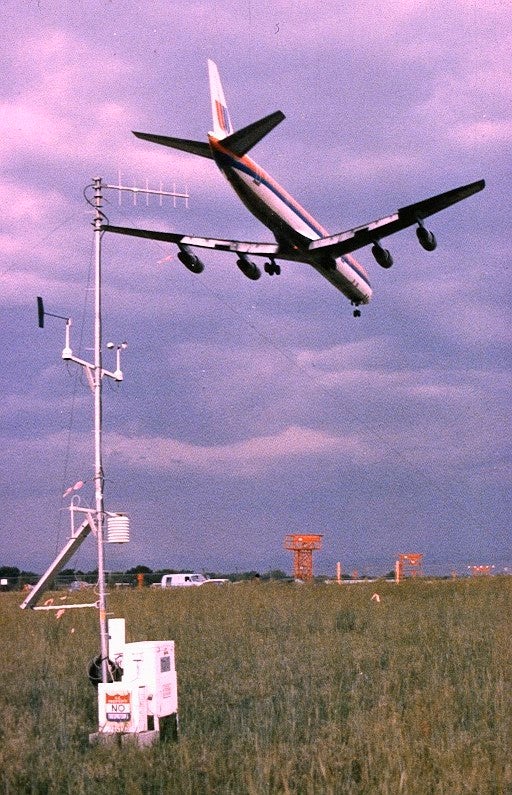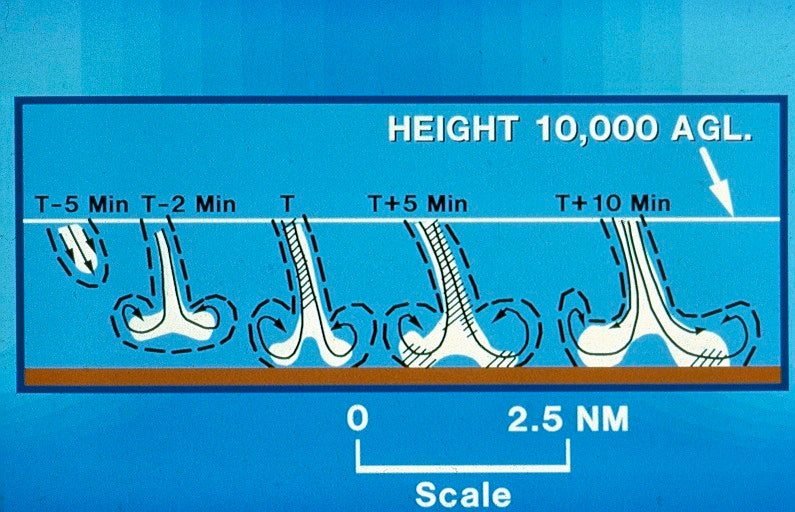JAWS
Joint Airport Weather Studies
The Joint Airport Weather Studies (JAWS) Project, formed in 1980, conducted a major field investigation during the summer of 1982 (15 May to 13 August, inclusive) in and around Denver, Colorado. The project was jointly administrated by the National Center for Atmospheric Research (NCAR) and the University of Chicago including collaboration with the National Oceanic and Atmospheric Administration (NOAA), The Federal Aviation Administration (FAA) and the National Aeronautics and Space Administration (NASA). The principle focus of JAWS was the convective microburst event, a small region of intense downflow and associated outflow which occurs in the convective boundary layer, usually but not always associated with thunderstorms. Microbursts can be lethal for a jet aircraft on takeoff or landing because of the extreme magnitude of the flows.
(Click for Full Resolution)
Science Objectives
The JAWS effort concentrated on three aspects of microburst-induced, low-level wind shear:
- Basic scientific investigation of microburst origins, lifecycles, and velocity structures
- Various aspects of aircraft performance, including numerical models, manned flight simulators, instrumented research aircraft response, and operational air carrier performance
- Low-level wind shear detection and warning using surface sensing, airborne systems, and radar sensing
 |
|
PAM station for JAWS. Photo courtesy UCAR.
(Click for Full Resolution) |
JAWS broadened the general weather hazard database by:
- providing data appropriate for real-time detection and warning of thunderstorm hazards for dissemination to the public and the aviation community;
- examining aircraft performance characteristics in wind shear conditions;
- providing a suitable real-time test bed for display software development;
- providing additional means to identify which scales of atmospheric motion were pertinent to applied objectives;
- providing an excellent test of optimal Doppler radar placement suitable for metropolitan and airport terminal coverage; and
- providing detailed perspective on the microburst hazard. Concurrent with JAWS, the Denver Airport Transportation Systems Center (TSC) sponsored a project to study the effect of weather on air traffic operations. Data were collected by photographing air traffic control terminals and by transcribing air traffic radio channels.
Facilities
| Radar | CP-2 Doppler S-band, CP-3 Doppler C-band, CP-4 Doppler C-band (NCAR); NOAA P-3 Aircraft X-band Doppler radar; and NOAA/NWS WSR-57 radar at Limon Colorado |
| Lidar/Profiler | WPL CO2 Doppler Lidar (NOAA); MSFC CO2 Doppler Lidar (NASA); and NOAA Profiler at DEN |
| Aircraft | University of Wyoming Beechcraft King Air 200T; NCAR Sabreliner N307D; NOAA P-3; UK Hawker-Siddeley 125 Executive Jet; and NASA B-57B; and NCAR Multiple Aircraft Positioning System (MAPS) |
| Surface | NCAR Portable Automated Mesonet (PAM) [27 stations]; NOAA PROFS Mesonet [22 stations]; NOAA pressure jump system [on 15 PAM stations]; FAA Low-Level Wind Shear Alert System (6 stations); NOAA Boulder Atmospheric Observatory Tower near Erie, Colorado |
| Lightning | NOAA PROFS Lightning Detection Array (3 stations) |
| Upper Air | NOAA/NWS special soundings (4 per day) at DEN |
| Photography | Cooperative Storm Intercept Group (COSIG); and CP-2 whole sky camera movies |
(Click for Full Resolution)
| Downburst hazard to landing aircraft. Courtesy Wilmot Hess. | Photo of a microburst. | John McCarthy (left) and Jim Wilson monitor radar signals from the JAWS control center east of Lafayette. Photo courtesy Charles Semmer. |
All photos copyright University Corporation for Atmospheric Research unless otherwise noted.
Principal Investigators:
- Ted Fujita U of C
- John McCarthy NCAR
- Jim Wilson NCAR
Data Manager:
- EOL Archive NCAR/EOL/DMS





